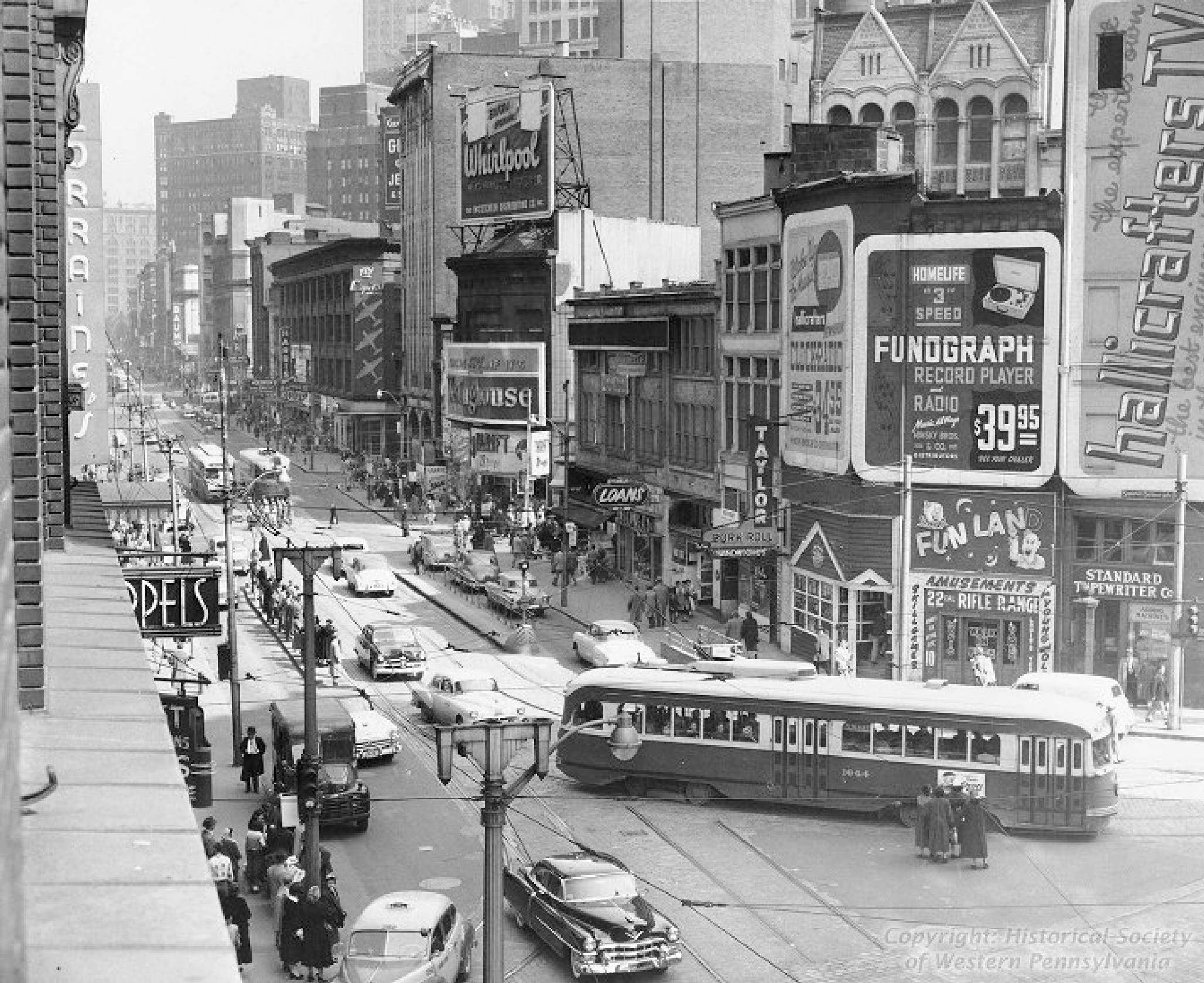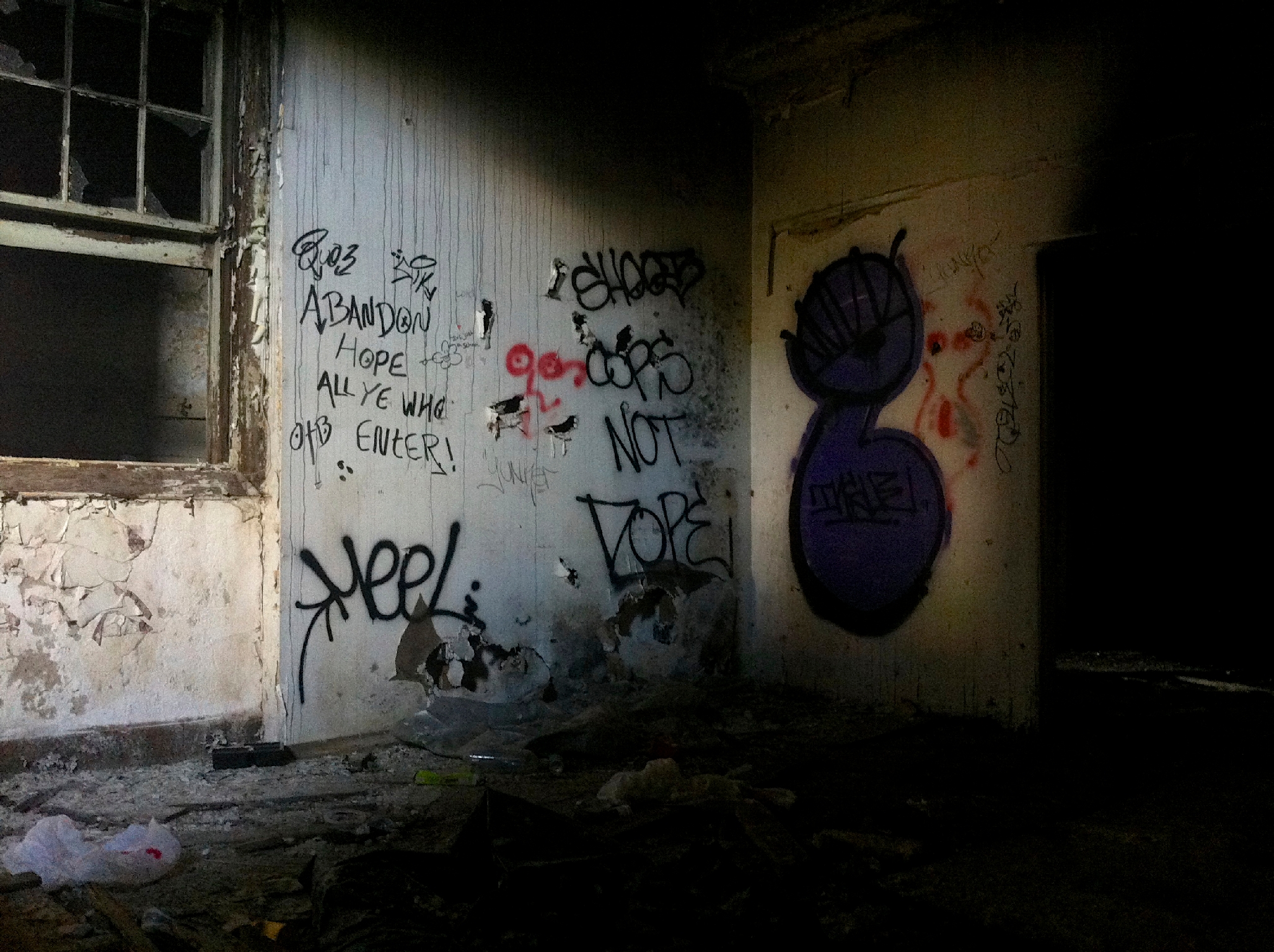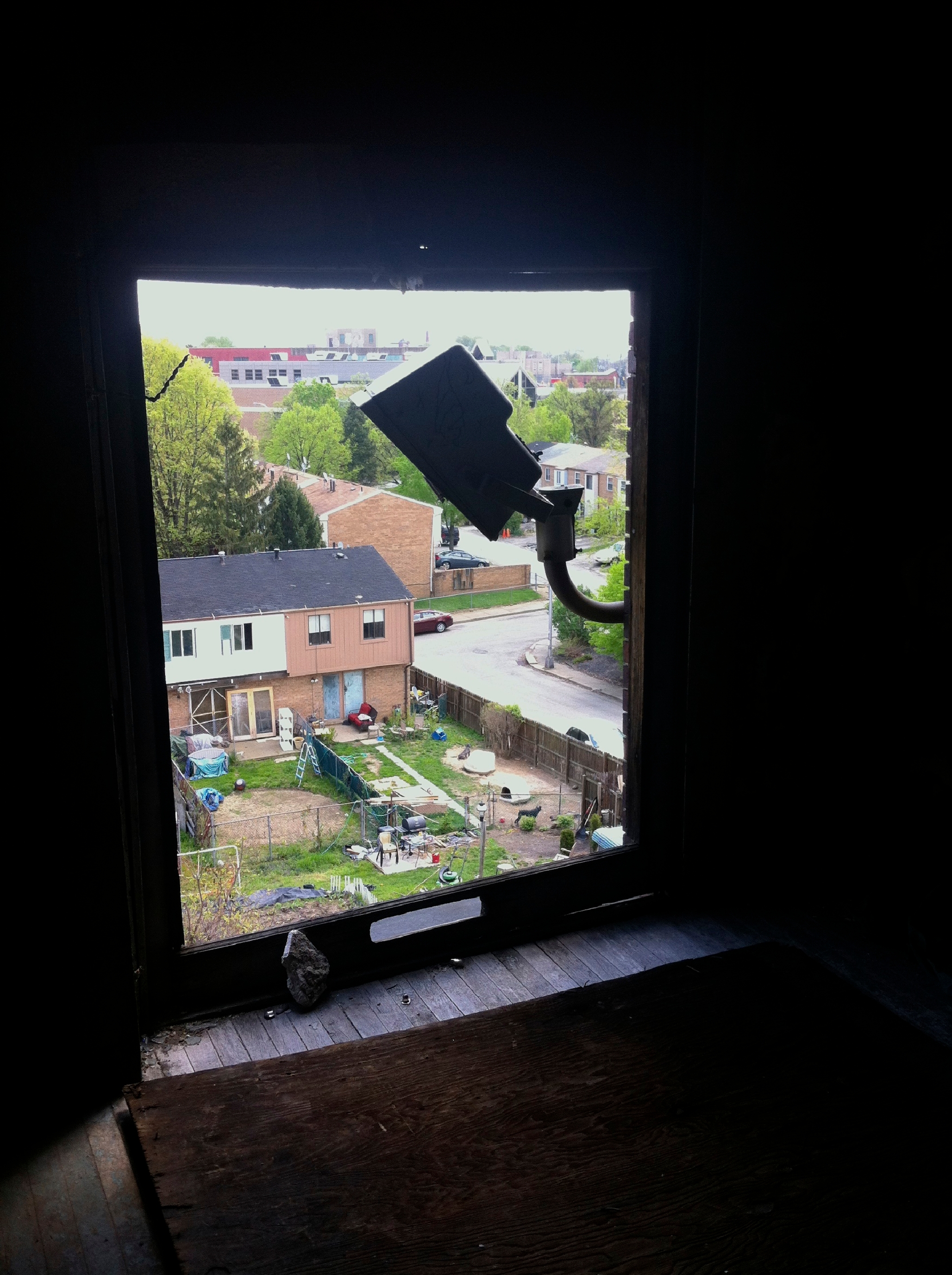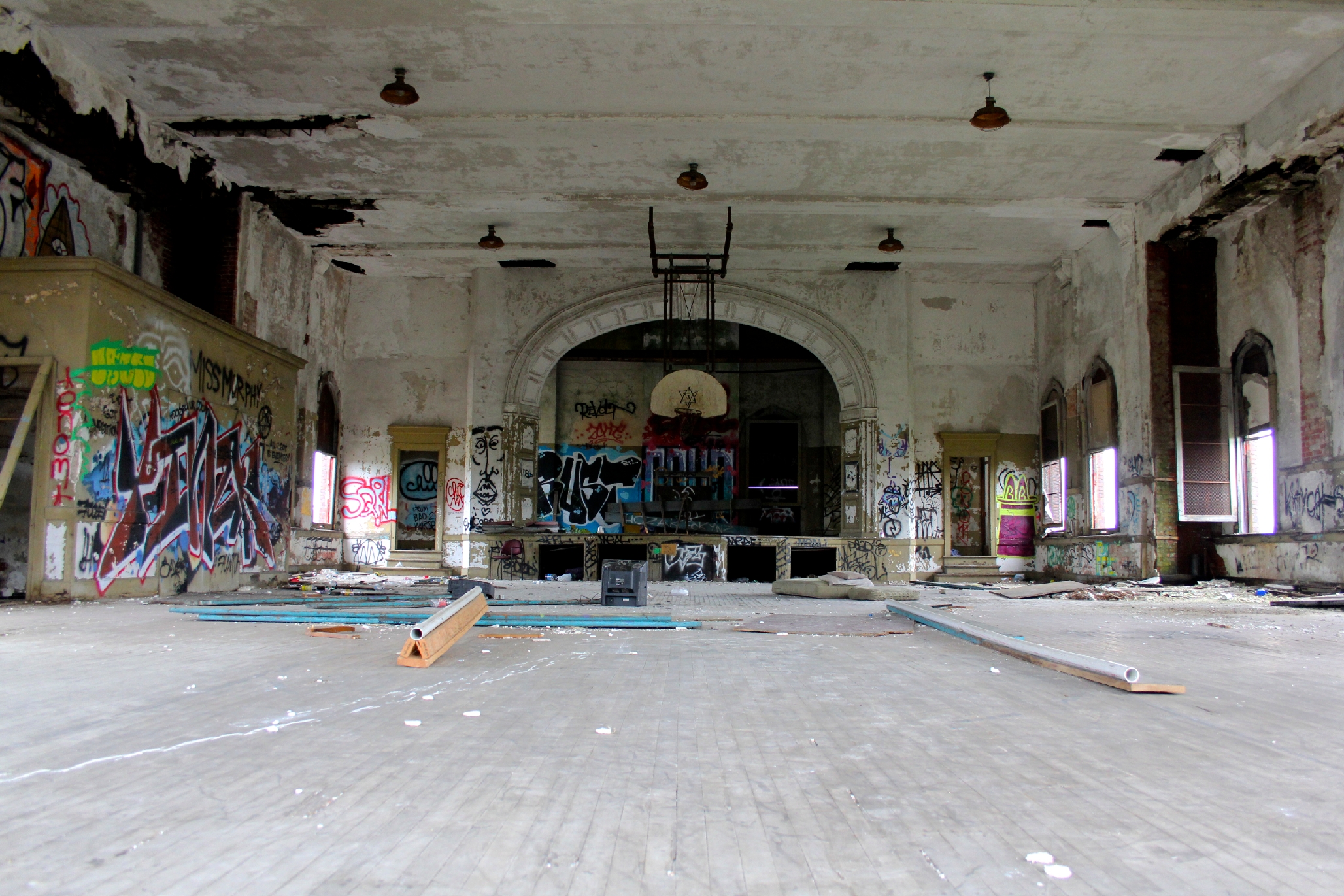Summer 2016
The Many Lives of Pittsburgh’s Saints Peter and Paul Church
– Rachel Mabe
Once a church and school for the middle class, Saints Peter and Paul Church reflects the changing landscape of Pittsburgh’s East Liberty neighborhood.
I stood looking at the door between the main hall of the big Catholic church and the rectory. Or rather, I stood looking at a hole in the building where a door used to be. At one point, it had been boarded up like the other windows and doors of the church. But now it stood free of both a door and plywood—just a dark hole in the back of a building. Ivy spread up over the stone and brick and a red Polo backpack lay discarded in the weeds next to the door. Blue, black, and red spray-painted letters decorated the surrounding walls.
I was trying to work up the courage to go inside. I had been here before, but I’d only gone into the four-story brick building behind the church. That building had once been a school, obvious through the identical classroom-sized rooms with chalk or corkboard lining the walls, the hooks for coats in the back of each room, and the gym on the top floor with basketball hoops on either end of the large room and the letters BLS painted into a logo in the middle of the wood floor.
A half hour before, I had started out from my apartment in Pittsburgh’s Friendship neighborhood. I’d walked northwest through the rapidly changing East Liberty neighborhood, where new construction from luxury condos to offices (like Google) to stores (like Target and boutiques) seemed to pop up weekly. After walking through Target and out the back exit, I took Larimer Avenue for the second time.
Shocked by how suddenly different the landscape was, I passed rundown low-income apartments on the right side of the street and newer apartments on the left. There was a large empty lot on the left and an empty ball field on the right, with several people standing behind the fence between the apartments and a small wooded area. And then this huge abandoned church. I could often see those 200-foot tall twin spires standing in the distance as I went about my daily life. Now up-close, I could see the iron fence with its half-open gate, ornate stained glass windows, a historic landmark plaque, and 10 steps leading to the boarded-up doors—one with a book-sized hole in it.
Behind the church I found an opening. I stepped over the doorframe and stood just inside, listening while my eyes adjusted to the dark. I could hear voices. I found a group of four boys smoking pot and sitting on a bench in the middle of the room. They looked young, maybe middle school age. The cavernous room was mostly dark, with some light filtered through the stained glass windows. Toward the front doors were piles of disassembled pews.
What did it say about property, the nature of space, and the once middle class neighborhood that it had been left open for people to reinhabit and use?
Standing there, I wondered how this big, beautiful church became a place for teens to smoke pot. How had this historic landmark that can be seen on the horizon from almost anywhere in Pittsburgh’s East End, that was in Kevin Smith’s cult classic film Dogma, come to this? Why were the spires, so majestic from a distance, shedding tiles and falling apart, the windows broken and walls covered in graffiti? It had started as a place of worship for people in the neighborhood. Now, it was abandoned and dilapidated and yet, still a space for people in the neighborhood. What did it say about property, the nature of space, and the once middle class neighborhood that it had been left open for people to reinhabit and use.
* * *
Originally the Catholics in East Liberty, a burgeoning German area in Pittsburgh, had to travel three and a half miles to the Strip District to worship formally. But in 1857, Saints Peter and Paul Roman Catholic Church was established. A two-year girls’ school that was connected to the church opened in 1905 in an old convent, to teach practical arts such as sewing, cooking, and dressmaking, and fine arts like music, painting, and drawing. It changed its name to Divine Providence Academy in 1922 and became a four-year high school. Girls flocked to the school from all over Pittsburgh and its suburbs. Most walked or rode the once-thriving trolley, but a handful lived there with the nuns.

A group of women who graduated in 1960 still meet at least once a year to catch up and reminisce. Last October, they gathered one Saturday at a Panera in Monroeville. Over sandwiches and bowls of soup, they talked about how they used to complain about the nuns, who required approval of everything—even their dresses and dates to dances—and the ridiculous uniforms the students wore. The uniforms don’t sound so bad now—a black jumper, a white blouse, black saddle shoes, and bobby socks. But the nuns made you order a couple sizes up so that the two uniforms purchased during the first year would last all four years of school. There was a belt, but the nuns said you looked like a sausage if you pulled too tight.
These women reminded each other that they mostly got a good education from the nuns who imparted a love of learning, teaching, and caring for others. Seven of their class of 53 students entered the convent, but many more became teachers and nurses. In 1964, Divine Providence Academy moved from the dilapidated old convent to a wealthy suburb and, 20 years later, shuttered their doors.
* * *
Back in the church I made my way over to the boys, introducing myself as I approached. They were wary of me, but not enough to leave or stop smoking their joint. The four sat close on a mauve pew-like bench. Grand columns rose up next to them and a large circular stained glass window loomed over their heads. An overturned bookshelf in front of them became a makeshift coffee table, covered with a bent hula hoop, folded newspaper, plastic soda cup, and drawings made on cardboard.
How had this historic landmark that can be seen on the horizon from almost anywhere in Pittsburgh’s East End, come to this?
They made me promise that I wasn’t a cop but they weren’t really worried. They came here after school pretty often to hang out and smoke pot, they said. They weren’t bad, they needed me to know. They were athletes, just “good kids that do bad things.” They’d been all through the church, upstairs to the organ and then higher, climbing attic-like stairs into the spires where they’d rocked their bodies against the large bells until the clapper hit the inside rim and rang out “gong!” for the entire neighborhood to hear. They’d been in the asbestos-filled rectory and graffiti-filled school. They told me matter-of-factly about the homeless people who lived on the property. They explained that there had been a fire in the church, started by one of the squatters, and warned me to avoid the left side if I went into a steeple. They didn’t know the story about the fire in one of the school’s classrooms that had charred the room into a black hush.
* * *
When Divine Providence Academy moved out of the convent, a pre-seminary school for boys, Bishop’s Latin School (BLS), moved in. Founded three years prior as an alternative to the other expensive Catholic school, they outgrew their space in a neighboring area and took over the old convent for classes. They had their gym in the brick building—hence the BLS still legible on the gym’s floor. In 1970 they moved to the South Side of Pittsburgh when the ceilings in the convent started to cave in. But they lasted only three years there as enrollment decreased.
BLS has been having alumni dinners for the past 13 years, four years longer than the school was in operation. Their dinners, at a seminary in Pittsburgh’s suburbs, include mass and a silent auction to fund scholarships for seminary school. One of their graduates became an ordained cardinal and at the alumni dinner last August he said, “Let Bishop’s Latin School not just be the past, but also the present and the future.”
Twenty-eight of the 250 boys who graduated from Bishop’s Latin School became ordained priests. But many others became lawyers following a commitment to social justice that Joe Hopper, class of ‘65, believes the school instilled in them. At least one became a carpenter, following “the steps of Jesus in a different direction.”
These are evidence of people reappropriating a place that official sources have left empty. In some ways it’s subversive; people taking a no longer useful space and making it useful again, leaving their mark on it through material culture, art, and vandalism.
After Bishop’s Latin School relocated to the South Side, the convent was demolished. The church still held services and a community organization, Operation Digs/Careers, Inc., found a home in the vacated school. That organization functioned as a job transition program that provided necessary skills training, helped with job searches, and offered literacy and GED classes. At an awards dinner in 1982 guest speaker Reverend Jesse Jackson told the audience of 500 that many social programs (food stamps for example) were white programs dressed up in blackface. But Operation Dig/Careers, Inc. was an organization run by a black man, Nate Smith, to help the disadvantaged. Meaning many East Liberty residents, which had changed from German to Italian to African American by the 1960s. As the Italians moved out they took a lot of their businesses with them and others were forced to close because changes in street design made it a difficult area to get to. Plus, it got increasingly dangerous—peaking in the early 1990s.
In 1992, the church closed because there weren’t enough parishioners to support it. Pittsburgh’s population had declined steadily since WWII and many other churches shuttered their doors. But did the closure of Saints Peter and Paul also have something to do with Catholics being unwilling to make the journey to East Liberty for mass? Isn’t the history of the church tied to the history of the neighborhood?

Now, standing with these boys who were reclaiming the church and giving it an unconventional new life, I thought about my love for abandoned buildings. I often find my way through busted windows or unlocked doors, without ever doing the busting myself. When I was young I wanted to be an archaeologist. I was drawn to that profession for the same reason I’m drawn to abandoned buildings. We can learn about the lives that were lived in or passed through a space by the marks they left on it.
I’ve come to think about my exploring self as an archaeologist of the present. And when I’m poking my way through abandoned buildings and looking at what’s left behind I’m examining the space and the material culture as an archaeologist—gathering information that tells the story of a place and its people. Sure, it’s fun to be in places where I’m not supposed to be, but it’s more than that. It’s about the essence of people that lingers, both in terms of the official uses a place had—like the pews and organ in the church, a red binder with the words “Educational Material” on the side in the school—but also what people have brought in since a place has been abandoned—potato chip bags, soda and beer cans, a bicycle tire, plastic flowers, rope, spare shoes and clothes, cardboard signs with messages such as “I appreciate any help, thanks + God bless.” These are evidence of people reappropriating a place that official sources have left empty. In some ways it’s subversive; people taking a no longer useful space and making it useful again, leaving their mark on it through material culture, art, and vandalism.

Five years after the church closed, Everlasting Covenant Church run by Ken Stevenson, who goes by Pastor Ken, bought the property—church and school—for $90,000 and planned to turn it into a charter school. Pastor Ken, a Pittsburgh native, had opened a successful private Christian school in New York state and wanted to do the same for his hometown. He named the school Renaissance Academy of Pittsburgh Alternative to Hope because its acronym RAPAH is close to the Hebrew word repah, meaning healing. The property needed renovations, so they opened the school in 2003 in an old, rented YMCA building a few blocks away.
The school operated for only three years and never moved to the Saints Peter and Paul property. In 2006, the local school board denied their charter renewal, citing a variety of violations. The school had made promises (computers available to each kid at home and school, cultural afterschool programs, Spanish class from kindergarten, and a longer school day and year) that they never fully fulfilled. Plus, they had operational issues; six employees had not completed the child abuse background clearance and the school ran a deficit of $627,276.

Pastor Ken said that he put a security system in the church and school, but people got in anyway, vandalized the property, and stole anything they could. He put a lot of the school files, like reduced lunch forms with social security numbers on them, in file cabinets in the church and bought a more advanced security system. But people found a way around that, too. Over the years he sort of gave up on securing the property. People took down the plywood that covered the doors and windows and no one replaced it. People brought spray-paint and wrote things on the walls like “Alone is all we are,” “All sparks burn out,” and “Miss Murphy…all I got is enemies” and no one painted over it. People broke windows and smashed furniture, televisions, anything they could find or bring in. They found places to sleep—sometimes on cushions and sometimes on the hard floor—and to shoot up, often leaving used needles on the ground. They found places to explore, hang out, use, and crash. They took an abandoned, empty place and reinhabited it. They put it to new use.
Pastor Ken balks at the word abandoned; the church is not and has never been abandoned. But East Liberty Development Group (ELDI) and the Pittsburgh courts disagree with him. ELDI is a nonprofit development group whose commitment is to “foster the revitalization” of East Liberty. The Allegheny Court of Common Pleas appointed ELDI as the property’s conservator last July. Kendall Pelling, ELDI’s director of land recycling, says they’ve been trying to buy the church for some time but the owners wanted “hundreds of thousands of dollars” for a property appraised at $25,000. Pastor Ken said he has tried unsuccessfully to reach Pelling for months. He was shocked when ELDI boarded up the buildings in October and put a steel door in both the church and school so that only ELDI personnel could get in and out. The sale has yet to go through, but ELDI plans to petition the court to supervise a sale.
ELDI’s aim is to secure the building and make it safe for the neighborhood. Their next plan of action is to repair the church’s roof. But their role is complicated. One of their initiatives involved identifying “hot spots” of crime (due to slumlords or abandoned properties). They then purchased these properties, renovated them, and became property managers. They’ve worked to keep housing affordable in East Liberty, but the value of residential properties has doubled as crime decreased by 49% between 2008-2012. Many new properties in East Liberty are mixed income, like the townhouses built on a previously empty lot across the street from the church. But there’s also a great deal of revitalization that’s changing the makeup of the neighborhood. The Target store is only about two blocks from Saints Peter and Paul and everything beyond that feels like a completely different place, part of an increasingly upscale area reaching to downtown that some are calling the Silicon Strip. But the neighborhood still struggles; just last September 14-year-old Desean Fountain was shot as he got off his bus between the church and Target, right next to the low-income housing complex.
* * *
So what does ELDI’s desire to secure the building and protect the neighborhood really come down to? Is ELDI’s concern truly about preserving the neighborhood or is it more interested in attracting new investment? Since its erection in the late 1800s, the property at 130 Larimer Ave (the church, the long torn down convent, the brick school building) has been a space for people in the community, a place for them to worship, to learn, to prepare for life, to seek help, or to rest for a while. Even when it was abandoned and vandalized and graffitied and full of questionable characters — people using drugs, whether it was teenagers or those in the throes of addiction, or just for sleeping —it was still space for the community. A place offering refuge, however precarious or dangerous, to those who needed it, to those who felt comfortable there, or those desperate enough to take it.
And now that the building is boarded up, it isn’t really anything—except a building on the horizon, revered as grand and majestic by some and an eyesore or a blight by others. And ELDI doesn’t know what to do with it. In 2012, a feasibility study found that everything except the rectory, which is full of asbestos, is structurally sound. But, Pelling explains, “It’s financially unviable. It’s a tough property to save and reuse” because it’s so large and has been stripped and vandalized for the past 20 years. It would need money to turn it into something else—estimates come in around five million dollars.

Pittsburgh doesn’t need another place for worship. Some churches without congregations have become other things: Church Brew Works transformed a Catholic church into a restaurant, Altar Bar and Mr. Smalls are concert venues in old Catholic churches, Angel’s Arms Condominiums turned a large Catholic church into upscale condos, and the Union Project, an artist collective and rental space, is housed in a once-Baptist church. But Saints Peter and Paul doesn’t easily lend itself to any of these things. It’s far bigger than most and turning such a large open space into apartments would require a complete overhaul. The school alone would be easier to contend with.
Pelling doesn’t know what realistic options there are for the church. ELDI is committed to getting community input. They know that many people are attached to the building’s mark on the landscape and that the building itself has historic significance. It is a historic landmark, after all, which matters to people (and complicates things). But what actually makes the most sense for the neighborhood? To tear it down and build something useful? Develop green space next to the ball field in hopes that people might actually use it? The graduates of Divine Providence Academy agreed that it’s sad to see churches in their disgraced state and it would be best to tear it down. Yet many residents of the apartments next to the church are attached it its presence. As one says, “That’s god’s house. I don’t care what kind of church it is. Tear down the buildings behind it, but leave the church.”

Abandoned buildings in poor urban and suburban areas across America are left without reuse plans. None of the Pittsburgh churches mentioned above that have found new uses are in poor black neighborhoods. Those neighborhoods seem left to taggers, drug users, and partiers. Revitalization efforts in East Liberty began in the early 1980s and have exploded over the past few years. Is this why the future of Saints Peter and Paul is being seriously addressed today? Because now that most of the neighborhood has transformed, the tentacles of revitalization has spread to the outskirts—to places like Saints Peter and Paul that borders a rundown neighborhood largely untouched by gentrification. Of course revitalization isn’t always bad. In this case, it’s forcing people to look at a community and an abandoned church that have long been ignored. But will this attention be able to bring the neighborhood back to a middle class standing or will it bypass that completely and become an affluent area? An area with unusually high rent for Pittsburgh like the recent development just a few blocks away near Target? One resident of the newer mixed income housing near the church explained, “High class people moving in means low class out. And it’s unfair. They have their choice of anywhere.”
* * *
One hot day Tasha and her friend Janaya, who held her infant son in her arms, talked to me in front of Janaya’s apartment. Tasha grew up here in the low-income apartment complex in the shadow of the church, but she’s moved a fifteen-minute drive away because it’s cheaper. Janaya moved here recently looking for more affordable rent when the neighborhood where she lived went beyond her price-range. They’d like for them to keep the church, but for it to become something useful for the people who live there—a community center and soup kitchen/food pantry. “We need that,” Janaya said. Angela Beasley, who has lived in the apartment complex for thirty years explained that everyone needed to prepare for changes to the church and the neighborhood, “Everything changes, even clothes. It’s going to change, so you have to be ready for it.”

The church looms over the rest of the two-story apartment buildings. From here in East Liberty, the tiles missing from the spires were so obvious that it was surprising it could ever be ignored from the distance. The property has changed hands often throughout its long history, but it always remained useful in some capacity. Even when Pastor Ken boarded it up, people broke in and reclaimed the unutilized space, making it their own. Since ELDI boarded it up in October, it has sat here useless, really useless, for the first time.
* * *
Rachel Mabe is currently a second year student in the University of Pittsburgh’s MFA program and an editorial assistant at VelaMagazine. Her work has appeared in VICE, Belt Magazine, and The Pittsburgh Anthology. Follow her @rachel_mabe.
Cover photo courtesy of Rachel Mabe